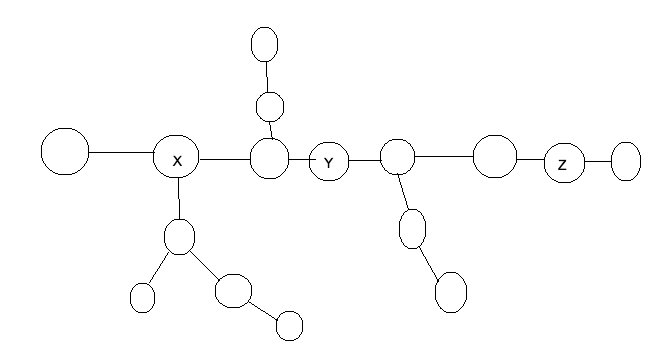I thought the explanations which I came up for Yestersday's A,C and E were easier to understand. So here they are.
A
hint
Try making solution of n=4 or n=5
solution
Handle $$$n=1$$$ ,$$$n=2$$$ and $$$n=3$$$ case separately Now $$$n>=4$$$ the answer will always have 9 in first position.Solution depends only on the first position at which we stopped.Suppose we stop at position $$$p>=3$$$.
If 1st position is stopped at time $$$t_1$$$, then second position must have stopped at time $$$t_2=t_1-1$$$, third at $$$t_3 = t_2-1 = t_1-2$$$ Since first position have 9 and second is stopped at a second earlier second position is 8 and similarly third position is 7.
If u have tried building solution for n=4 you must have observed that it is possible to 989 in first three positions respectively which better solution than the one we tried to construct above. Thus stopping at 2nd position when it shows 8 is optimal solution.
To construct rest of the string s[I]=(s[I-1]+1)%10
code
#include<iostream>
using namespace std;
int main(){
int te;cin>>te;
while(te--){
int n;cin>>n;
if(n==1){cout<<"9\n";continue;}
if(n==2){cout<<"98\n";continue;}
if(n==3){cout<<"989\n";continue;}
int ans[n];
ans[0]=9;
ans[1]=8;
ans[2]=9;
for(int i=3;i<n;i++)ans[i]=(ans[i-1]+1)%10;
for(int i=0;i<n;i++)cout<<ans[i];
cout<<endl;
}
}
C
hint
We are first trying to create a max negative value which we will then in final step subtract from a positive value
solution
Suppose the bags are $$$a_1,a_2,a_3……a_{n_1}$$$
$$$b_1,b_2,b_3…..b_{n_2}$$$
$$$c_1,c_2,c_3……c_{n_3}$$$
Let $$$SUM=a_1+a_2+a_3….+a_{n_1}+b_1+b_2+b_3….+b_{n_2}+c_1+c_2+c_3….+c_{n_3}$$$
We can have mainly have two type of final values
First We can subtract values $$$b_2,b_3,b_4…..b_{n_2}, c_1,c_2,c_3……c_{n_3}$$$ from $$$a_1$$$
The value of $$$a_1$$$ would then be $$$a_1-b_2-b_3-b_4…..b_{n_2}-c_1-c_2-c_3…..-c_{n_3}$$$
And then finally subtract $$$a_1,a_2,a_3…..a_{n_1}$$$ from $$$b_1$$$
The value of $$$b_1$$$ would then be
$$$b_1-(a_1-b_2-b_3-b_4…..b_{n_2}-c_1-c_2-c_3…..-c_{n_3})-a_2-a_3-a_4…a_{n_1}$$$
$$$=b_1+b_2+b_3….b_{n_1}+c_1+c_2+c_3…..+c_{n_3}-a_1-a_2-a_3-a_4…a_{n_1}$$$
$$$=sum-2*(a_1+a_2+a_3….a_{n_1})$$$
Second Another answer that we can construct is
Subtract values $$$b_2,b_3,b_4…..b_{n_2}, c_2,c_3……c_{n_3}$$$ from $$$a_1$$$
NOTE we are not subtracting $$$c_1$$$
The value of $$$a_1$$$ will be $$$a_1-b_2-b_3-b_4…..b_{n_2}-c_2-c_3…..-c_{n_3}$$$
Subtract values $$$a_2,a_3…..a_{n_1}$$$ from $$$c_1$$$
The value of $$$c_1$$$ will be $$$c_1-a_2-a_3-a_4…..a_{n_1}$$$
And then finally subtract $$$a_1$$$ and $$$c_1$$$ from $$$b_1$$$
The final value would then be
$$$b_1-(a_1-b_2-b_3-b_4…..b_{n_2}-c_2-c_3…..-c_{n_3})-(c_1-a_2-a_3-a_4…..a_{n_1})$$$
$$$=b_1+b_2+b_3….b_{n_2}+c_2+c_3+….c_{n_3}+a_2+a_3+a_4…a_{n_1}-a_1-c_1$$$
$$$=sum-2*(a_1+c_1)$$$
Thus the $$$answer=max(sum-2*(a_1+a_2+a_3….a_{n_1}),sum-2*(a_1+c_1))$$$
$$$Answer=sum-min(2*(a_1+a_2+a_3….a_{n_1}),2*(a_1+c_1))$$$
$$$Ans=sum-2*min((a_1+a_2+a_3….a_{n_1}),a_1+c_1)$$$
I have considered bags randomly without loss of generality
That mean I want to compare the bag which has minimum and sum of minimum elements of any two bags
code
#include<iostream>
#include<bits/stdc++.h>
using namespace std;
int main(){
int n1,n2,n3;
cin>>n1>>n2>>n3;
long long a[n1], b[n2], c[n3];
long long sum=0,sum_of_a=0,sum_of_b=0,sum_of_c=0;
long long min_elements[3]={(long long)1e9+3,(long long)1e9+3,(long long)1e9+3};
// 0 1 2 stores min elements of bag a b and c respectively
for(int i=0;i<n1;i++){cin>>a[i];sum+=a[i];sum_of_a+=a[i];min_elements[0]=min(min_elements[0],a[i]);}
for(int i=0;i<n2;i++){cin>>b[i];sum+=b[i];sum_of_b+=b[i];min_elements[1]=min(min_elements[1],b[i]);}
for(int i=0;i<n3;i++){cin>>c[i];sum+=c[i];sum_of_c+=c[i];min_elements[2]=min(min_elements[2],c[i]);}
sort(min_elements,min_elements+3);
long long min_sum_bag=min(sum_of_a,sum_of_b);
min_sum_bag=min(min_sum_bag,sum_of_c);
sum-=2*min(min_elements[0]+min_elements[1],min_sum_bag);
cout<<sum<<endl;
}
E
Solution
Let us see when the answer is definitely 0
Suppose three vertices x,y,z exists such that ax=ay=az and y lies on path from x to z (or z=x since undirected tree both are same)
In this scenario the answer is always 0.
This can be understood by the given image (I was not write the formal proof)
Try getting a distinctive root in this tree
After checking the above case we can simply iterate over nodes in any order.
Suppose we are node v If the value of the node is unique i.e. no other other element has same value as this node we don't need to anything. Otherwise we check which edge of this node leads us to another node having same value.
The condition which we checked initially assures that there will be exactly one such edge for each node.
Let this edge be E.Now all the node which do not contain this edge in their path to v cannot be distinctive roots. Once you try few cases of own it easy to understand why.
To implement the above solution we can arbitrarily root the tree, do a dfs and assign each vertex a in and out time. Now if we are at vertex v and vertex w is connected to v by an edge E1!=E we can cancel off all the vertex in subtree of v. To do so we can maintain array fin with initial values 0 and reduce all values from in[v] to out[v]+1 time.
Now to obtain final answer iterate over all node and if fin[in[v]]==0 increase answer.
code
Don't have clean implementation at the moment. I will write and update if this blog got some likes.










Auto comment: topic has been updated by three_nil (previous revision, new revision, compare).
Nice E explanation, but I have another question. How were you able to take part in Div3 a few days ago? Your rating was clearly higher than 1600, more like 1800. Makes Div3's a bit unfair.
I get that the new calculation system has something to do with it — but system is supposed to recognize your true rating just like when making rating calculations.
EDIT: My bad, all good. [
Why do you think so?
Not a word about true rating, moreover, true rating is not public, wouldn't it be weird if you couldn't understand whether you can participate from public information in your profile?
My bad, thanks for the correction. Don't know what I was thinking...
Auto comment: topic has been updated by three_nil (previous revision, new revision, compare).
Your solution use a segment tree with dfs order instead of rerooting. Am I understanding correctly?
I have not used segment tree.
reduce all values from in[v] to out[v]+1 time
If you are talking about using segment tree for this , yes you can use segment tree but it can be done using a simple array also.
A suggestion : Use Latex when doing math, it looks cleaner and easier to read — like $$$a_1,a_2...a_{n_1}$$$
Thanks for the nice explanations btw
Done! Thanks for the advice.
Another small suggestion, in case you don't want to write a clean solution for E, you could add a link to this solution. I think it uses the same idea as yours, and is sufficiently clean.
Auto comment: topic has been updated by three_nil (previous revision, new revision, compare).
Wow! Your editorial is better than the official one.
sooooooooooooooo useful, u r god